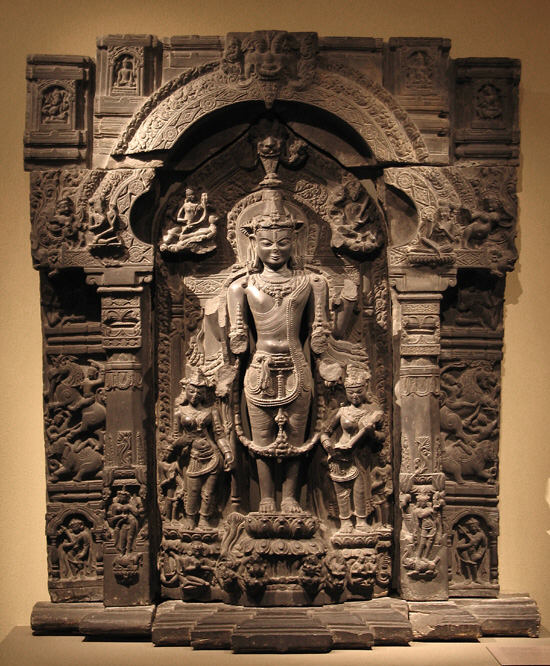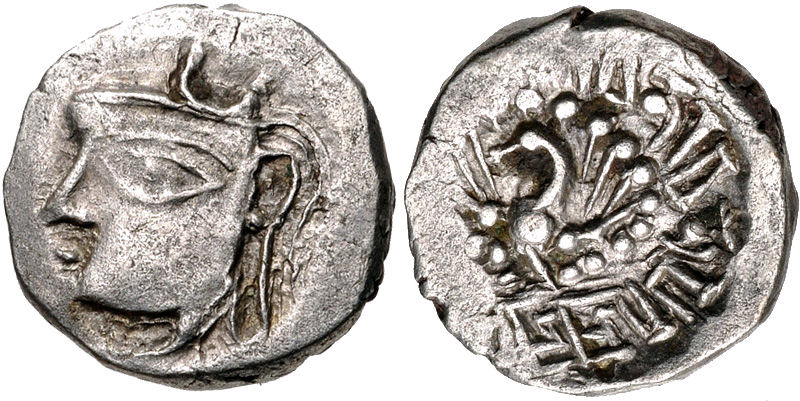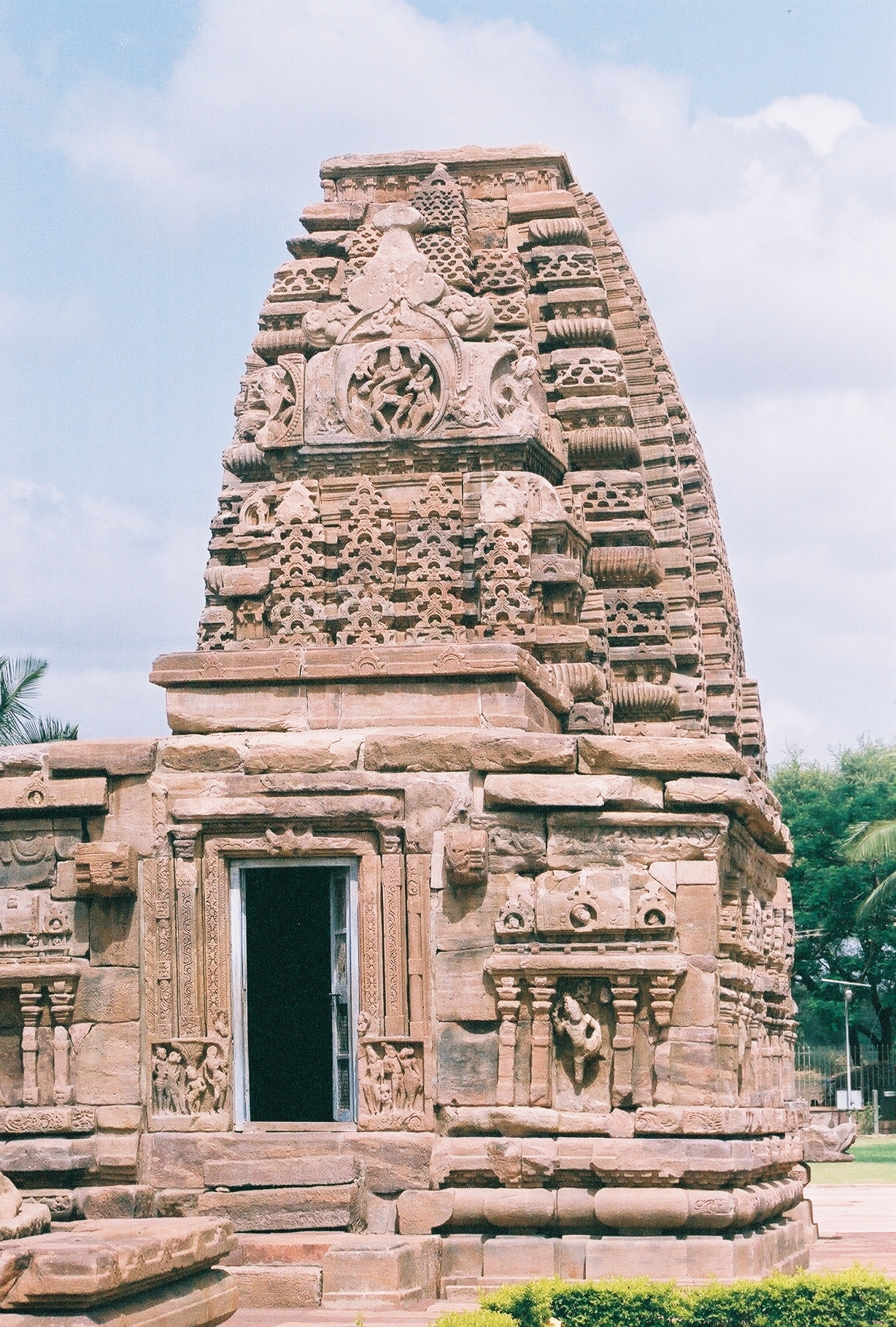|
Gurjara-Pratiharas
The Gurjara-Pratihara was a dynasty that ruled much of Northern India from the mid-8th to the 11th century. They ruled first at Ujjain and later at Kannauj. The Gurjara-Pratiharas were instrumental in containing Arab armies moving east of the Indus River. Nagabhata I defeated the Arab army under Junaid and Tamin in the Caliphate campaigns in India. Under Nagabhata II, the Gurjara-Pratiharas became the most powerful dynasty in northern India. He was succeeded by his son Ramabhadra, who ruled briefly before being succeeded by his son, Mihira Bhoja. Under Bhoja and his successor Mahendrapala I, the Gurjara-Pratihara dynasty reached its peak of prosperity and power. By the time of Mahendrapala, the extent of its territory rivalled that of the Gupta Empire stretching from the border of Sindh in the west to Bengal in the east and from the Himalayas in the north to areas past the Narmada in the south. The expansion triggered a tripartite power struggle with the Rashtrakuta and Pa ... [...More Info...] [...Related Items...] OR: [Wikipedia] [Google] [Baidu] |
Pala Empire
The Pāla Empire (r. 750-1161 CE) was an imperial power during the post-classical period in the Indian subcontinent, which originated in the region of Bengal. It is named after its ruling dynasty, whose rulers bore names ending with the suffix ''Pāla'' ("protector" in Prakrit). The empire was founded with the election of Gopāla as the emperor of Gauda in late eighth century AD. The Pala stronghold was located in Bengal and eastern Bihar, which included the major cities of Gauḍa, Vikramapura, Pāṭaliputra, Monghyr, Somapura, Ramavati ( Varendra), Tāmralipta and Jaggadala. The Pālas were astute diplomats and military conquerors. Their army was noted for its vast war elephant corps. Their navy performed both mercantile and defensive roles in the Bay of Bengal. At its zenith under emperors Dharmapala and Devapala in the early ninth century, the Pala empire extended their dominance into the northern Indian region, with its territory stretching across the Gangetic pl ... [...More Info...] [...Related Items...] OR: [Wikipedia] [Google] [Baidu] |
Nagabhata I
Nagabhata I (r. c. 730 – 760 CE) was a king who founded the imperial Gurjara Pratihara dynasty of northern India. He ruled the Avanti (or Malava) region in present-day Madhya Pradesh, from his capital at Ujjain. He may have extended his control over the Gurjara country, which includes parts of present-day Gujarat and Rajasthan. He repulsed an Arab invasion from Sindh, probably led by Junayd ibn Abd al-Rahman al-Murri or Al Hakam ibn Awana. Early life Nagabhata has been named as the founder of the imperial Gurjara-Pratihara dynasty in the Gwalior inscription of his descendant Mihira Bhoja. The exact date of Nagabhata's accession is not known. His grand-nephew Vatsaraja is known to have been ruling in Avanti in 783–784 CE. Assuming a period of 25 years for each generation, Nagabhata can be presumed to have ascended the throne around 730 CE. The Gwalior inscription traces the dynasty's origin to the legendary hero Lakshmana. Nagabhata's historical antecedents ... [...More Info...] [...Related Items...] OR: [Wikipedia] [Google] [Baidu] |
Caliphate Campaigns In India
In the first half of the 8th century CE, a series of battles took place between the Umayyad Caliphate and kingdoms to the east of the Indus river, in the Indian subcontinent. Subsequent to the Arab conquest of Sindh in present-day Pakistan in 712 CE, Arab armies engaged kingdoms further east of the Indus. Between 724 and 810 CE, a series of battles took place between the Arabs and Nagabhata I of the Gurjara-Pratihara dynasty, Vikramaditya II of the Chalukya dynasty, and other small Indian kingdoms. In the north, Nagabhata of the Pratihara Dynasty defeated a major Arab expedition in Malwa. From the South, Vikramaditya II sent his general Avanijanashraya Pulakeshin, who defeated the Arabs in Gujarat. Later in 776 CE, a naval expedition by the Arabs was defeated by the Saindhava naval fleet under Agguka I. The Arab defeats led to an end of their eastward expansion, and later manifested in the overthrow of Arab rulers in Sindh itself and the establishment of indigenous Muslim d ... [...More Info...] [...Related Items...] OR: [Wikipedia] [Google] [Baidu] |
Kalachuris Of Tripuri
The Kalachuris of Tripuri (IAST: ), also known the Kalachuris of Chedi, ruled parts of central India during 7th to 13th centuries. They are also known as the Later Kalachuris to distinguish them from their earlier namesakes, especially the Kalachuris of Mahishmati. Their core territory included the historical Chedi region (also known as Dahala- mandala), and their capital was located at Tripuri (present-day Tewar near Jabalpur, Madhya Pradesh). The origin of the dynasty is uncertain, although one theory connects them to the Kalachuris of Mahishmati. By the 10th century, the Kalachuris of Tripuri had consolidated their power by raiding neighbouring territories and by fighting wars with the Gurjara-Pratiharas, the Chandelas and the Paramaras. They also had matrimonial relations with the Rashtrakutas and the Chalukyas of Kalyani. In the 1030s, the Kalachuri king Gangeyadeva assumed imperial titles after achieving military successes at his eastern and northern frontiers. ... [...More Info...] [...Related Items...] OR: [Wikipedia] [Google] [Baidu] |
Kanauj
Kannauj (Hindustani pronunciation: ənːɔːd͡ʒ is a city, administrative headquarters and a municipal board or Nagar Palika Parishad in Kannauj district in the Indian state of Uttar Pradesh. The city's name is a corrupted form of the classical name ''Kanyakubja''. It was also known as ''Mahodaya'' during the time of Mihira Bhoja Kannauj is an ancient city. It is said that the Kanyakubja Brahmins who included Shandilya (teacher of Rishi Bharadwaja) were held one of the three prominent families originally from Kannauj. In Classical India, it served as the center of imperial Indian dynasties. The earliest of these was the Maukhari dynasty, and later, Emperor Harsha of the Vardhana dynasty.Tripathi, ''History of Kanauj'', p. 192 The city later came under the Gahadavala dynasty, and under the rule of Govindachandra, the city reached "unprecedented glory". Kannauj was also the main place of war in the Tripartite struggle between the Gurjara-Pratihara, the Palas and ... [...More Info...] [...Related Items...] OR: [Wikipedia] [Google] [Baidu] |
Kannauj
Kannauj (Hindustani pronunciation: ənːɔːd͡ʒ is a city, administrative headquarters and a municipal board or Nagar Palika Parishad in Kannauj district in the Indian state of Uttar Pradesh. The city's name is a corrupted form of the classical name ''Kanyakubja''. It was also known as ''Mahodaya'' during the time of Mihira Bhoja Kannauj is an ancient city. It is said that the Kanyakubja Brahmins who included Shandilya (teacher of Rishi Bharadwaja) were held one of the three prominent families originally from Kannauj. In Classical India, it served as the center of imperial Indian dynasties. The earliest of these was the Maukhari dynasty, and later, Emperor Harsha of the Vardhana dynasty.Tripathi, ''History of Kanauj'', p. 192 The city later came under the Gahadavala dynasty, and under the rule of Govindachandra, the city reached "unprecedented glory". Kannauj was also the main place of war in the Tripartite struggle between the Gurjara-Pratihara, the Palas and ... [...More Info...] [...Related Items...] OR: [Wikipedia] [Google] [Baidu] |
Yasahpala (king)
Yasahpala or Jasapala was the last king of the Imperial Pratihara dynasty, who ruled from 1024 till 1036 CE. He succeeded his father, Trilochanapala (1018–1027). The Pratihara authority had shrunk considerably only to the city of Kannauj Kannauj (Hindustani pronunciation: ənːɔːd͡ʒ is a city, administrative headquarters and a municipal board or Nagar Palika Parishad in Kannauj district in the Indian state of Uttar Pradesh. The city's name is a corrupted form of the cla ... and the surrounding region. References Pratihara empire History of Rajasthan History of Gujarat 11th-century Indian monarchs {{India-royal-stub ... [...More Info...] [...Related Items...] OR: [Wikipedia] [Google] [Baidu] |
Rashtrakuta Dynasty
Rashtrakuta ( IAST: ') (r. 753-982 CE) was a royal Indian dynasty ruling large parts of the Indian subcontinent between the sixth and 10th centuries. The earliest known Rashtrakuta inscription is a 7th-century copper plate grant detailing their rule from manapur a city in Central or West India. Other ruling Rashtrakuta clans from the same period mentioned in inscriptions were the kings of Achalapur and the rulers of Kannauj. Several controversies exist regarding the origin of these early Rashtrakutas, their native homeland and their language. The Elichpur clan was a feudatory of the Badami Chalukyas, and during the rule of Dantidurga, it overthrew Chalukya Kirtivarman II and went on to build an empire with the Gulbarga region in modern Karnataka as its base. This clan came to be known as the Rashtrakutas of Manyakheta, rising to power in South India in 753 AD. At the same time the Pala dynasty of Bengal and the Prathihara dynasty of Malwa were gaining force in easte ... [...More Info...] [...Related Items...] OR: [Wikipedia] [Google] [Baidu] |
Indus River
The Indus ( ) is a transboundary river of Asia and a trans-Himalayan river of South and Central Asia. The river rises in mountain springs northeast of Mount Kailash in Western Tibet, flows northwest through the disputed region of Kashmir, Quote: "Kashmir, region of the northwestern Indian subcontinent. It is bounded by the Uygur Autonomous Region of Xinjiang to the northeast and the Tibet Autonomous Region to the east (both parts of China), by the Indian states of Himachal Pradesh and Punjab to the south, by Pakistan to the west, and by Afghanistan to the northwest. The northern and western portions are administered by Pakistan and comprise three areas: Azad Kashmir, Gilgit, and Baltistan, ... The southern and southeastern portions constitute the Indian state of Jammu and Kashmir. The Indian- and Pakistani-administered portions are divided by a "line of control" agreed to in 1972, although neither country recognizes it as an international boundary. In addition, China be ... [...More Info...] [...Related Items...] OR: [Wikipedia] [Google] [Baidu] |
Hindustan
''Hindūstān'' ( , from '' Hindū'' and ''-stān''), also sometimes spelt as Hindōstān ( ''Indo-land''), along with its shortened form ''Hind'' (), is the Persian-language name for the Indian subcontinent that later became commonly used by its inhabitants in the Hindi–Urdu language. Hindustan was the Persian word for ''India'', but when introduced to the subjects under Persianate rule, the subsequent culture which resulted from these events gave it another specific meaning that of the cultural region between the river Sutlej (end of Northwestern India) and the city Varanasi (start of Eastern India). As the area where Ganga-Jamuni Tehzeeb and the Hindustani language traces its origins, it corresponds to the plains where the river Yamuna flows or the regions/states encompassing Haryana, Delhi, Harit Pradesh, and Awadh. Other toponyms for the subcontinent include '' Jambudvīpa'' and ''Bharata Khanda''. Since the Partition of India in 1947, although limitedly, ''H ... [...More Info...] [...Related Items...] OR: [Wikipedia] [Google] [Baidu] |
Prakrit
The Prakrits (; sa, prākṛta; psu, 𑀧𑀸𑀉𑀤, ; pka, ) are a group of vernacular Middle Indo-Aryan languages that were used in the Indian subcontinent from around the 3rd century BCE to the 8th century CE. The term Prakrit is usually applied to the middle period of Middle Indo-Aryan languages, excluding earlier inscriptions and the later Pali. ''Prākṛta'' literally means "natural", as opposed to '' saṃskṛta'', which literally means "constructed" or "refined". Prakrits were considered the regional spoken (informal) languages of people, and Sanskrit was considered the standardized (formal) language used for literary, official and religious purposes across Indian kingdoms of the subcontinent. Literary registers of Prakrits were also used contemporaneously (predominantly by śramaṇa traditions) alongside Classical Sanskrit of higher social classes. Etymology The dictionary of Monier Monier-Williams (1819–1899), and other modern authors however, interpr ... [...More Info...] [...Related Items...] OR: [Wikipedia] [Google] [Baidu] |
Sanskrit
Sanskrit (; attributively , ; nominalization, nominally , , ) is a classical language belonging to the Indo-Aryan languages, Indo-Aryan branch of the Indo-European languages. It arose in South Asia after its predecessor languages had Trans-cultural diffusion, diffused there from the northwest in the late Bronze Age#South Asia, Bronze Age. Sanskrit is the sacred language of Hinduism, the language of classical Hindu philosophy, and of historical texts of Buddhism and Jainism. It was a lingua franca, link language in ancient and medieval South Asia, and upon transmission of Hindu and Buddhist culture to Southeast Asia, East Asia and Central Asia in the early medieval era, it became a language of religion and high culture, and of the political elites in some of these regions. As a result, Sanskrit had a lasting impact on the languages of South Asia, Southeast Asia and East Asia, especially in their formal and learned vocabularies. Sanskrit generally connotes several Indo-Aryan lang ... [...More Info...] [...Related Items...] OR: [Wikipedia] [Google] [Baidu] |








